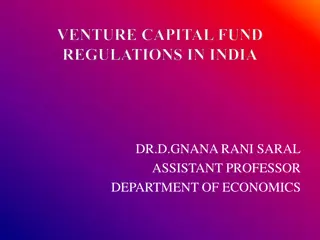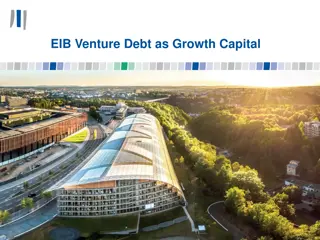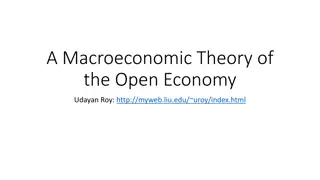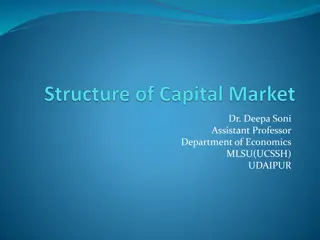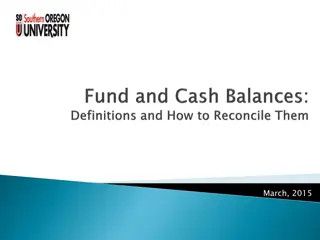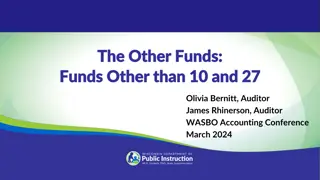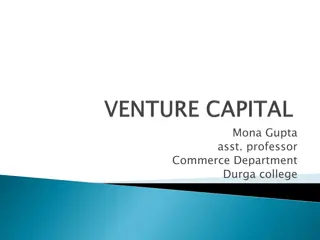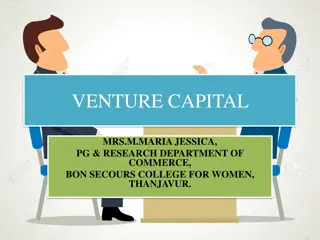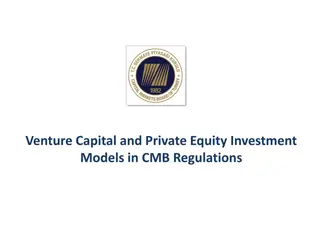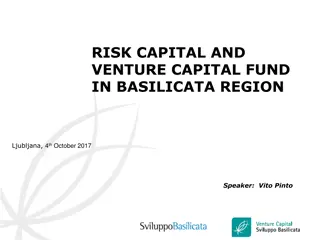Possibilities for Venture Capital Funds in Republic of Serbia
The paper discusses the differences between investment funds, venture capital funds, and private equity, the determinants influencing the development of these funds, and the current state of venture capital in Serbia. It also touches upon legal regulations impacting these funds and explores various factors affecting the development of venture capital.
Download Presentation

Please find below an Image/Link to download the presentation.
The content on the website is provided AS IS for your information and personal use only. It may not be sold, licensed, or shared on other websites without obtaining consent from the author.If you encounter any issues during the download, it is possible that the publisher has removed the file from their server.
You are allowed to download the files provided on this website for personal or commercial use, subject to the condition that they are used lawfully. All files are the property of their respective owners.
The content on the website is provided AS IS for your information and personal use only. It may not be sold, licensed, or shared on other websites without obtaining consent from the author.
E N D
Presentation Transcript
Possibilities for the Development of Venture Capital Funds in the Republic of Serbia BILJANA URI I , MA1 1WESTERN SERBIA ACADEMY OF APPLIED STUDIES, REPUBLIC OF SERBIA, BILJANA.DJURICIC@VPTS.EDU.RS
Abstract: The paper will present the basic differences between investment funds, venture capital funds and private equity. It will presents the basic determinants of the development of private and venture capital funds and discuss the current state of private and venture capital funds in the Republic of Serbia The legal regulations for the development of these funds will also be presented. Keywords: risk capital, venture capital, investment funds
1. INTRODUCTION Venture capital (VC) is long-term, hands-on equity investment in privately held, high growth- potential companies, initiated and managed by professional investors [1]. Private equity covers not only the financing required to create a business, but also includes financing in the subsequent stages of its life cycle.
There are 12 main differences between PE and VC: - Stage - Company Types - Deal size: - Percentage Acquired - Risk Appetite - Structure - Return Differences - Operations Involvement - Effort - Pay - Culture - Exit
2. DETERMINANTES OF VENTURE CAPITAL The development of risk capital funds is affected by determinants which can be divided into macro and institutional S. Bonini and S. Alkan (2006), based on annual data from 16 countries between 1995 and 2000 total value of stock traded, GDP growth, corporate income tax rate, total entrepreneurial activity, inflation, labor market rigidities, and some of political risk variables investment profile, socioeconomic conditions and corruption Elisabete Gomes Santana F lix et al. (2013) based on data from 23 countries VC capital for the period from 1992 to 2003 GDP growth rate, Market capitalization, Long term interest rate - positive impact The unemployment rate - negative impact
van Pottelsberghe de la Potterie, Bruno; Romain, Astrid (2004). panel dataset of 16 OECD countries from 1990 to 2000 Interest rates and CDP growth rate, growth rate of R&D investment, the available stock of knowledge and the number of high value patents Abouzar Najmi (2019) across G7 countries over 2007-2017 Interest rate, unemployment rate, market capital, market capital return and ease to starts a business Mondher Cherif (2011) across 21 European countries over 1997-2006 GDP growth, market capitalization, R&D expenditures and unemployment rate, property rights freedom, financial freedom and trade freedom play Grilli et al. (2018) - systematic literature review regulatory policies, indicators of government quality, financial markets and other contextual determinants
3. SERBIA VENTURE CAPITAL IN REPUBLIC OF According to Milenkovic N. the main potential sectors for VC investments in Serbia are: Electricity, gas, steam and air conditioning supply, Information and communication, Wholesale and trade on retail, repair of motor vehicles and motorcycles, Manufacturing industry and Real estate activities The basic precondition for the development of venture capital funds in the Republic of Serbia is the Law on Alternative Investment Funds By law, there are open and closed alternative investment funds (AIF) Open AIF has the form of separate assets and do not have the status of legal entities and they organize and manage by Management company of Alternative Investment Funds (AIFM). Currently there are no venture capital funds in Serbia. There are several regional venture capital funds that have offices in Serbia to support the capacity building of portfolio companies, although these venture capital funds are registered in countries with preferential tax status. The venture capital fund with the highest visibility in Serbia is the Innovative Enterprise Fund (ENIF), which is currently managed by the South Central Ventures Fund.
The following share capital funds are most prominent in Serbia: Enterprise Enlargement Fund (ENEF) SEAF Balkan Fund Blue Sea Capital Serbian Private Capital Fund (SPEA)
4. CONCLUSION Domestic companies have identified access to finance as the second most important problem they face, right behind the problem of finding customers (new markets). Venture capital funds have proven to be a good solution for financing development projects of fast-growing companies (popularly: gazelles) in countries with mature market economies. The most important determinants of venture capital development are: GDP growth rate, market capitalization, interest rate and unemployment rate as macroeconomic determinantes and property rights freedom, financial freedom and trade freedom as institutional determinantes. The basic precondition for the development of venture capital funds in the Republic of Serbia is the Law on Alternative Investment Funds. Currently there are no venture capital funds In Serbia, but it can be expected to be open first one.
REFERENCES [1] Basel, LPX GmbH Z rich January 2009. [2] Krzysztof Dzieko ski, S awomirIgnatiuk. Venture capital and private equity investment preferences in selected countries, e- Finanse 2015, vol. 11 / nr 3 [3] Bonini, Stefano et al. The Macro and Political Determinants of Venture Capital Investments around the World. (2006). [4] Elisabete Gomes Santana F lix and Cesaltina Pires. The Determinants of Venture Capital in Europe - Evidence Across Countries, Journal of Financial Services Research,2013. [5] van Pottelsberghe de la Potterie, Bruno; Romain, Astrid. TheDeterminants of Venture Capital: Additional Evidence, Discussion Paper Series 1, No. 2004,19, Deutsche Bundesbank, Frankfurt a. M. [6] Abouzar Najmi. The Determinants of Venture Capital Funding in G7 Countries, Working paper, 2019. [7] Cherif Mondher and Gazdar Kaouthar. What Drives Venture Capital Investments in Europe? New Results from a Panel Data Analysis, Journal of Applied Business and Economics vol. 12(3) 2011 pp 122-139 [8] Luca Grilli , Gresa Latifi and Boris Mrkajic. Institutional determinants of venture capital activity: an empirically driven literature review and research agenda, Journal of Economic Surveys 2019 Vol. 33, No. 4, pp. 1094 1122 [9] Milenkovic N. Strategija privlacenja rizicnog i privatnog kapitala u uslovima trzisnog ambijenta Srbije, Skola biznisa, br 2/2017 [10] The Law on Alternative Investment Funds (Republic of Serbia Official Gazette, No 73/2019) Bastian Bergmann, Hans Christophers, Matthias Huss, Heinz Zimmermann. Listed Private Equity Working Paper, University of







